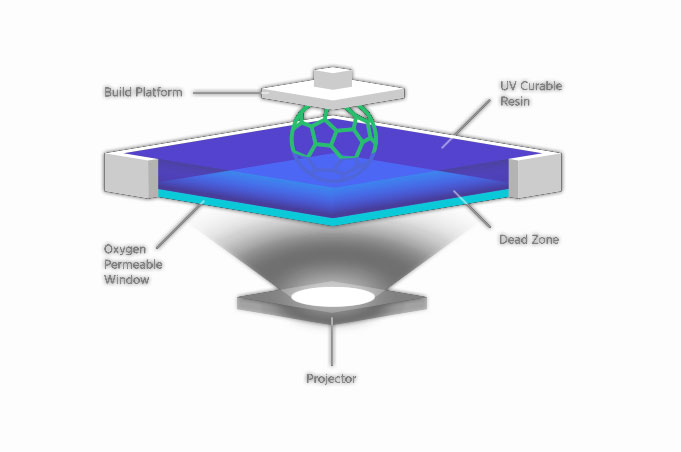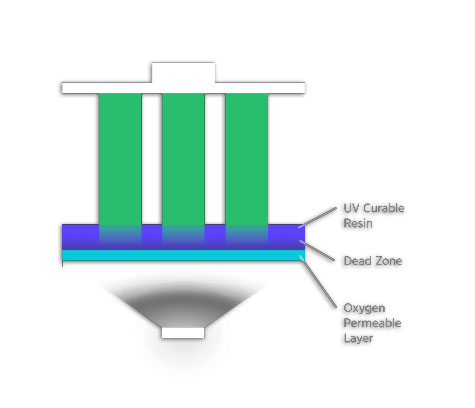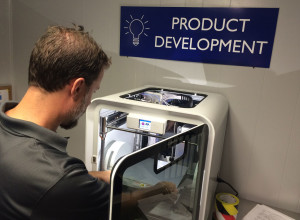
The Present and Future of 3D Printing
3D printing technology is advancing at an astonishing rate. Every day we hear about a new technique such as metal, glass, and even wood 3D printing.
The use of 3D printers for mass production is still far away. The technology for building prototypes, however, is still astounding. Clients can provide us with a sketch on a napkin from which we can create concept drawings, 3D models and a printed prototype in as little as 24 hours. Ten years ago, this simply wasn’t possible. We look forward to the next ten years of 3D printing technology advances and how they will bring our “Big Ideas” to life.
3D printing actually 2D prints 3D objects by drawing one layer on top of another. This is very useful, but does have structural limitations. 3D printed objects do not have the same strength or flexibility as the final injection molded product. This makes it more difficult to use the prototype for strength or endurance testing. As manufacturers, we currently rely on our understanding of and experience with a polymer’s properties and behavior before tooling and manufacturing the final part. This works well for most projects. But with more complicated applications, material and time restrictions can easily cause delays and higher costs in the production of the final product.
CLIP (Continuous Liquid Interface Production)
One new technology we are particularly excited about is CLIP (Continuous Liquid Interface Production). Remember the movie Terminator 2, where robots seem to just form out of a bed of liquid metal? This inspired the founders of Carbon3D (Joseph M. DeSimone, Alex Ermoshkin, Ed Samulski and Steve Nelson) to invent a totally new technique for polymer-based 3D printing. This technique is still being perfected, but the company is currently working with Ford and Legacy Effects to help create production quality prototypes and excellent Hollywood special effects.
How Carbon3D’s CLIP technology works
According to Carbon3D, CLIP production is a breakthrough technology that grows parts instead of printing them layer by

layer. CLIP allows businesses to produce commercial quality parts at game-changing speeds, creating a clear path to 3D manufacturing. Here’s how CLIP works:
Essentially the printer uses a basin full of a special liquid polymer that reacts to UV light and oxygen. The UV light hardens
the polymer, and oxygen prohibits it from hardening; this process is called “photopolymerization”. The bottom of the basin is made of a membrane similar to a contact lens that allows UV light to be projected into the liquid polymer and, at the same time, oxygen to enter into the resin. Carbon3D’s printer uses


The advantages of this process include quicker production times and freedom to use a wider range of materials than traditional 3D printing. Parts created by this revolutionary process also have the same structure and strength as injection molded parts
having been created solid, instead of being printed layer by layer.
According to Carbon3D, CLIP technology is 25 to 100 times faster than Polyjet, SLS, and SLA 3D printers.
Experts think this little company is on to something big – Google Ventures led a $100 million investment in the company this year. The CLIP printers are currently not available to the public but, with the company being led by engineers and developers from companies like Tesla Motors, Ford and Google, the future looks bright for this technology.
More on the Horizon for 3D Printing
CLIP technology is just one example of research and development of 3D printer technology; this year, the FDA approved the first 3D printed pill. Researchers in Korea have created 3D printed graphene nanowires. Graphene is a lightweight, high-strength super conductor that can be used in electronics. U.S. researchers have 3D printed a structure that they believe will help nerves repair themselves. At MIT’s Computer Science and Artificial Intelligence Laboratory, a team has built a 3D printer that can make objects using ten different materials in one print. Even more impressive – they built the machine for less than $7,000 using off-the-shelf components.
Someday, manufacturers will be able to build just about anything customers may ask for with one single machine. 3D printer technology currently available cannot compete with injection molding on speed and strength. Even though we’re not sure exactly where the future of 3D printers may take us, we will definitely continue to have a lot of fun bringing it to our customers.

